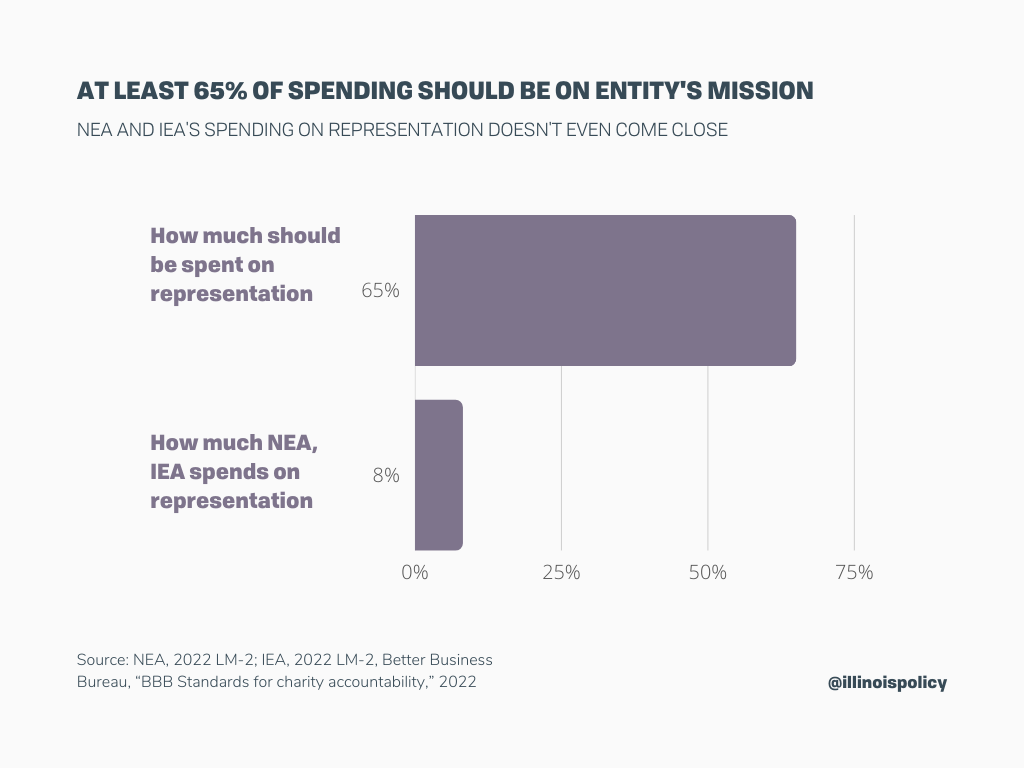NEA, IEA spend little on representing teachers, but prioritize politics
Less than 8% of NEA and IEA’s spending in 2022 was on representing teachers, according to the unions’ federal reports. That could be why nearly 203,000 public school employees – including more than 6,000 in Illinois – have left NEA since 2017.
How an organization spends its money reveals a lot about that organization’s priorities, so for the National Education Association and its state affiliate, the Illinois Education Association, the priority is not representing teachers.
Less than 8% of NEA and IEA’s combined spending in 2022 was on representing teachers, according to their federal filings with the U.S. Department of Labor. In fact, NEA spent more on politics than it did on representing its members.
That could be why so many teachers are leaving the union. Since 2017, NEA has seen nearly 203,0000 teachers and other public school employees nationwide stop paying dues or fees to the union. That includes more than 6,000 in Illinois.
Most of a teacher’s dues money doesn’t stay local, but instead flows up the chain to the national and state affiliates.
Illinois teachers concerned about how NEA and IEA spend their hard-earned money have options. They can stop paying dues by opting out of union membership yet maintain all of the raises and other benefits their employers provide. Other professional organizations can provide liability insurance and job protection coverage, often at a fraction of the price of union membership.
Less than 8% of NEA and IEA’s combined spending was on representing teachers in 2022
NEA and IEA spent a combined $659 million in 2022, according to the unions’ LM-2s, which are reporting documents the unions filed with the U.S. Department of Labor.
Yet just $50 million of that was on “representational activities,” which the department states are activities “associated with preparation for, and participation in, the negotiation of collective bargaining agreements and the administration and enforcement of the agreements.”
That means less than 8% of IEA and NEA’s combined spending was on representing teachers, the core purpose of the union. The rest was spent on politics, administration and other union leadership priorities.

To place this in perspective, the Wise Giving Alliance, a project of the Better Business Bureau, maintains a nonprofit should spend at least 65% of its total expenses on program activities.

While the Wise Giving Alliance tracks spending by charities, it stands to reason IEA and NEA’s spending of less than 8% on representation – the purpose of a union – should be a cause for concern among members.
NEA spent more on politics than representing teachers in 2022
NEA prioritized politics over teachers in 2022, spending $41.6 million on “political activities and lobbying” and just $37.9 million on representing teachers. Its political spending included more than $13.2 million to NEA’s own “advocacy fund.” Once funds are transferred, NEA members have no say in how or on what causes those funds are spent.
NEA also spent an additional $119.6 million on “contributions, gifts and grants” – three times more than it spent on representational activities. Many of those contributions were also political in nature, such as:
- $2.5 million to For our Future Action Fund, which claims to “build progressive power”
- $500,000 to Building Back Together, the organization “advanc[ing] the policy agenda of the Biden-Harris Administration”
- $450,000 to Strategic Victory Fund, which seeks to build “the infrastructure needed to build long-term progressive agendas and issue advocacy in states”
- $395,000 to Chicago-based Midwest Academy, a training organization that claims “empowering progressive organizers is our mission”
- $300,000 to America Votes, the “coordination hub of the progressive community”
- $270,000 to Democracy Alliance, an organization seeking to “advance progressive policy reforms”
- $225,000 to State Innovation Exchange, which equips legislators to “move bold, progressive public policy”
- $150,000 to Progressive Caucus Action Fund, which publishes a “progressive playbook”

NEA’s priorities are clear. Its political agenda – and not representing teachers – is No. 1.
Teacher union membership is in decline
IEA and NEA’s poor spending practices and failure to prioritize members could be why so many teachers are leaving the union.
In Illinois, at least 6,314 public school employees have stopped paying dues or fees to IEA since 2017, according to the union’s 2017 and 2022 LM-2s. Nationwide, NEA has seen a decline of 202,933.
But Illinois educators who want more control over their dues have options:
- Teachers can get liability insurance and legal protection elsewhere. Educators can join other associations, such as the Association of American Educators. AAE, which has 29,000 members across the country, provides liability insurance and legal protection to public school employees – typically at a fraction of the cost of union membership.
- Teachers can opt out of union membership and keep all employer-provided benefits. By opting out of union membership, a teacher stops paying dues to the union yet retains all benefits that are provided in the collective bargaining agreement with the school district.
Opting out doesn’t mean educators don’t support their local bargaining unit. In fact, educators are free to send voluntary donations to their local bargaining units without being members – thereby helping to ensure their support stays local.
For more information, visit LeaveIEA.com.
